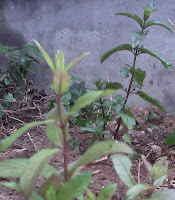It grows like a weed, asking for little more than space and time. There are many, many kinds, it's native to this region, and you can get starts from friends or family who have too much.
How can you have too much mint? That just doesn't make sense...A little bit of mint is a great addition to salads or punches up almost any dish (a low-sodium alternative to salt in many cases); it's a legendary-class tea and also good in coffee. (That shot of mint in your latte? why not use leaves!)
Our house has an angle we call the "armpit", a moist area where an extension meets the body of the building. It's overgrown with ferns and a shrub that really don't please us; we think it's one of the spots we're getting mosquitos. Also, they don't contribute to the economic sustainability we're working towards.
Therefore this weekend I cleaned out a bit of the armpit to experiment with native mint. My mother-in-law provide two varieties of starts from her boyfriend's house, and they fit right into the area. I added some biomass when planting them since the soil felt a little depleted.
While planting the starts, I kept getting whiffs of that wonderful minty smell, making this one of the most pleasant planting jobs ever!
With this planting, we can expect to save a little money over time, since in a few months this source of mint will displace about 1 box of purchased tea per month. This reduces also the energy cost of shipping that product. This impacts are not fantasticly huge, but the start-up costs were zero and every little bit helps!

1 comment:
Excellent! I adore mint ... I love it chopped over curries and rolled up in spring rolls ... sliced thinly and put over fresh fruit ... yummy and refreshing.
Herbs are such a good thing ... and most of them are hardy and grow almost anywhere. And don't you think mint is just a beautiful plant. Who need ornamentals ... I opt for herbs and veggies ... beautiful plants!
BTW ... love the new look of your blog!
Hope your surviving the Seattle heat! Take care!
SF
Post a Comment